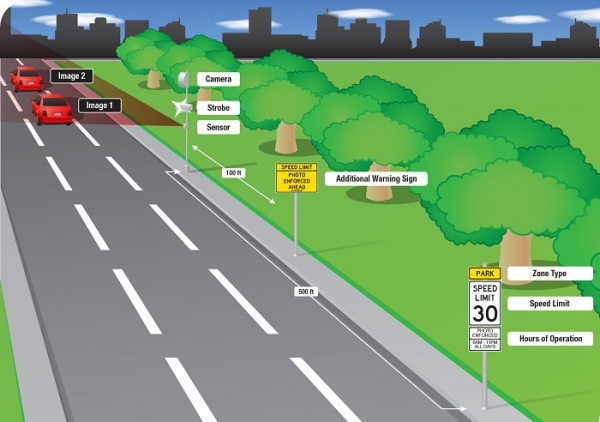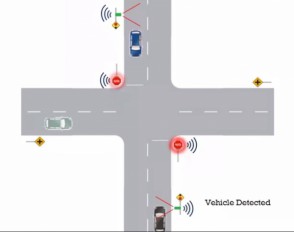Automated speed enforcement system boosts road safety and reduces crime

The automated speed enforcement systems have undoubtedly improved road safety by decreasing collisions. In addition, they have also reduced crime incidents, a new study shows.
Automated speed enforcement is a safety method developed to reduce excessive speeding. The system utilizes a fixed or a mobile camera and additional equipment to detect vehicles passing by at high speeds. This technology features a lot of benefits including:
- Most drivers' behavior instinctively changes due to the presence of the system.
- It operates in locations where police personnel cannot easily access.
- It enforces the speed limit impartially and consistently without additional resources and staff.
The study was conducted by researchers from the University of British Columbia. They utilized data from automated photo enforcement systems between 2013 and 2015 in the city of Edmonton, Canada. Their findings showed a reduction both in vehicle collisions and in criminal incidents in the area the system was utilized.
According to the researchers, the automated speed enforcement system prevents criminals from committing an illegal action. “Our results prove that automated speed enforcement, which uses cameras to detect and capture images of vehicles exceeding the speed limit, reduces collisions as well as discourages crime. People intending to commit crime are usually deterred by the presence of authority. Since criminals also tend to show unsafe driving behaviors, you can expect to see fewer collisions due to the presence of automated speed enforcement,” Shewkar Ibrahim, leader of the research and traffic safety engineer for the City of Edmonton, said.
The research team also developed a tool that can be utilized to determine where new automated speed enforcement systems should be installed. “Using this tool, we can see how many collisions can be prevented by spending a certain number of hours at a given location. We can then assign resources to where they are most needed,” Mrs. Ibrahim stated.
In the future, the system can fully replace manned enforcement, according to study's co-author, Tarek Sayed, UBC professor of civil engineering and Canada Research Chair in Transportation Safety and Advanced Mobility. “Automated enforcement has always been a contentious issue, and so having this evidence to show its dual benefits will hopefully promote its use as a tool for improving community safety. This is the first study to show that automated enforcement is absolutely effective in reducing both collisions and crimes,” Prof. Sayed stated.
Sources: University of British Columbia, Sfmta.com
Sources: University of British Columbia, Sfmta.com
Want to read more like this story?

Researchers study the necessary road infrastructure preparation before the circulation of automated vehicles
Jun, 29, 2017 | NewsIt should be able to support the transition period and become the basis for the future, fully automa...

Automobile technological features save $6.2 billion annually
Jan, 09, 2019 | NewsThe first study to evaluate the effects of smart technologies on fuel consumption shows that a remar...

From Setback to Progress: The Future of UK Road Safety
Sep, 19, 2024 | NewsThe United Kingdom, once a global leader in road safety, has seen its progress stagnate over the pa...

Road safety increased due to cycling lanes
Jun, 28, 2019 | NewsA detailed study shows that cycling lanes have made the roads safer for everyone. Scientists from...

From 5.5 Hours to 3: How High-Speed Rail Will Change Travel in Canada
Mar, 05, 2025 | NewsCanada is set to embark on one of its most ambitious infrastructure projects—the 1,000-kilometre hi...

U.S. Interstate Highway System needs severe improvements
Jan, 08, 2019 | NewsAccording to a new report, the U.S. Interstate Highway System needs overhaul in order to addres...

Transatlantic Tunnel: A Bold Vision or an Impossible Dream?
Mar, 04, 2025 | NewsImagine traveling from New York to London in just 54 minutes—a journey that currently takes over se...

Alibaba's artificial intelligence system to alleviate traffic
Feb, 15, 2019 | NewsA sophisticated artificial intelligence (AI) system has been delivered to address traffic issues in...

Self-powered thermal system to improve road safety
Mar, 22, 2019 | NewsA brand-new self-powered thermal device that will alert motorists for potential dangers is being tes...
Trending

Taipei 101’s impressive tuned mass damper

Characteristics of Load Bearing Masonry Construction

Morocco Implements Landmark Dam Perforation to Combat Water Stress in Marrakech

The Line at Neom faces feasibility reassessment while construction continues

Dutch greenhouses have revolutionized modern farming

Suspension bridge buckles under force of deadly super typhoon in Philippines

Egypt and Qatar launch $29.7 billion Mediterranean coastal real-estate project

